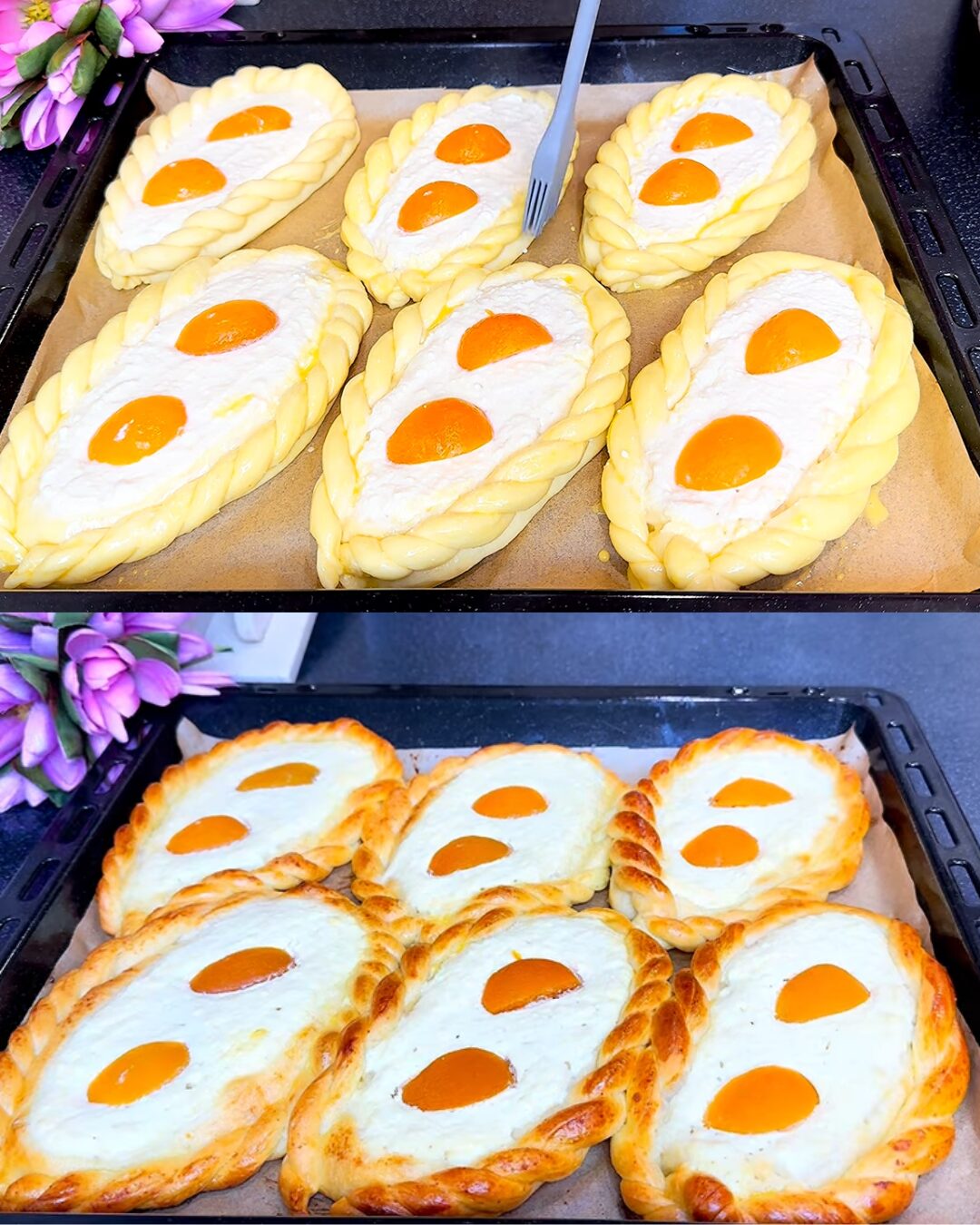Imagine waking up to the tantalizing aroma of freshly baked, buttery buns filled with a sweet, creamy cottage cheese center—perfectly golden and warm, best enjoyed with a steaming cup of tea or coffee. These Sweet Cottage Cheese Buns draw inspiration from Eastern-European vatrushki, a beloved pastry combining light, enriched dough and a velvety cheese filling. Though rooted in tradition, this recipe is both accessible and impressive, offering home bakers a chance to create something that feels both comforting and elegant. With straightforward steps, high‑quality results, and a nostalgic twist, these buns make weekend mornings feel special or festive occasions extra delightful. Whether you’re sharing with family or indulging solo, these buns are bound to leave a lasting impression.
Cooking Time
-
Preparation Time: 20 minutes
-
First Rise: 50 minutes
-
Shaping & Filling: 15 minutes
-
Final Proof: 15 minutes
-
Baking Time: 20 minutes
-
Total Time: Approximately 2 hours
Ingredients
For the Enriched Dough:
-
70 g granulated sugar
-
1 large egg
-
½ tsp fine salt
-
250 ml warm milk (100–110 °F / 37–43 °C)
-
9 g fresh compressed yeast (or 3 g active dry yeast)
-
40 ml ghee (clarified butter) or unsalted butter, melted
-
Approximately 450 g all‑purpose flour
-
1 tsp vegetable oil (for greasing)
For the Cottage Cheese Filling:
-
200 g full‑fat cottage cheese or farmer’s cheese
-
2 tbsp sifted powdered sugar
-
1 egg white (from a large egg)
Step‑by‑Step Cooking Directions
1. Activate the Yeast
In a large mixing bowl, stir together warm milk, sugar, and fresh yeast. Allow the mixture to rest for about 5 to 10 minutes until it becomes frothy and aromatic—indicating that the yeast is alive, active, and ready to help create a beautifully risen dough.
2. Enrich the Dough
Beat in the egg and salt until fully incorporated. Whisk in the melted ghee to provide tenderness and golden flavor. Begin stirring in the flour gradually—start with around 400 g—until a shaggy dough forms. You want to end up with a soft, supple dough that holds together without being sticky.
3. Knead to Perfection
Turn the dough onto a lightly floured work surface. Knead by hand for 5–7 minutes until the dough becomes smooth, elastic, and springs back at the touch of your finger. If the dough is overly sticky, add a tablespoon or two of flour, but be careful not to over-flour and risk a tough texture.
4. First Rise (Fermentation)
Rub a bit of vegetable oil inside the mixing bowl. Return the dough, cover with plastic wrap or a clean towel, and allow to rise in a warm (75–85 °F / 24–29 °C) draft-free environment for 50 minutes, or until it doubles in size. The dough should feel light and airy when gently pressed.
5. Prepare the Filling
While the dough rises, make your filling. Mix cottage cheese, powdered sugar, and the beaten egg white in a small bowl until smooth. The filling should be creamy, slightly loose but stable—easy to spoon but not runny.
6. Divide and Relax the Dough
Once the dough has risen, deflate it gently. Place it on a lightly floured surface and divide it into eight equal pieces (each about 120 g). Shape each piece into a smooth ball, then cover and let them rest for 10 minutes to relax the gluten before shaping.
7. Shape the Buns
Flatten each ball to approximately 10 cm (4‑inch) diameter. Gently press the centers to create a shallow well (about 2 cm / ¾ in deep). The raised rim forms a nest that keeps the filling in place. Place each shaped round seam-side down on a baking sheet lined with parchment.
8. Fill and Proof
Spoon a generous tablespoon of the cheese filling into each well. Cover lightly with plastic wrap or a towel, and allow the buns to proof again for 15 minutes. During this time, preheat your oven to 180 °C (350 °F) so it’s ready once the buns are settled and puffed.
9. Optional Egg‑Wash
For a shiny, golden finish, you can brush the edges with egg yolk mixed with a teaspoon of milk. This gives your buns that bakery-glaze goodness.
10. Bake to Golden Delight
Transfer the trays to the middle rack of your preheated oven. Bake for 20 minutes, or until the dough achieves a rich golden-brown color, and the cheese centers are set but still moist. Avoid over-baking to keep the interior soft.
11. Cool and Enjoy
Allow the buns to cool on the sheet for about 5 minutes, then transfer them to a wire rack. Serve warm or at room temperature—either way, they’re irresistible alongside tea or coffee.
Nutritional Information (per bun estimate)
-
Calories: ~240 kcal
-
Protein: 8 g
-
Carbohydrates: 35 g
-
Sugars: 10 g
-
Fat: 7 g
-
Fiber: 1 g
These values may vary slightly based on cheese type, flour brands, or butter substitutions used.
The Origins and Popularity of the Recipe
These buns are inspired by Eastern-European vatrushki, a traditional pastry beloved in Russia, Ukraine, Poland, and the Baltics. Vatrushki come in both sweet and savory forms, often filled with fresh cheese or jam and baked until golden. The name comes from the regional word vatra, meaning “fire” or “hearth”—a nod to their cozy, home-baked identity. This version modernizes the tradition: enriched dough with ghee, powdered sugar for a refined sweetness, and a consistent bun shape. The recipe pays homage to time‑honored flavor while offering a fresh, simple technique that’s approachable for any home baker.
Reasons Why You’ll Love This Recipe
-
Elegant and satisfying: The buns look and taste bakery-grade, yet they’re made entirely at home.
-
Delightfully soft: Enriched with butter and milk, the dough has a tender, pillowy texture.
-
Creamy filling: Cottage cheese adds protein and a clean taste, balanced by sweetness.
-
Versatile: Serve them warm with tea or as a dessert, snack, or gift.
-
Family‑friendly: A fun activity—young bakers can help shape the buns.
Health Benefits
-
Protein and calcium from cottage cheese
-
Low refined sugar (just enough for sweetness)
-
No artificial additives—simple pantry ingredients
-
Self‑portioned baking—unlike oversized pastries, you get satisfying single servings
Serving Suggestions
-
Pair with hot black tea or Earl Grey
-
Fresh berries or fruit salad complement the creamy filling
-
Drizzle honey or berry compote over filled buns for extra sweetness
-
Spread thick yogurt, lemon curd, or jam for brunch flair
Common Mistakes to Avoid
-
Using hot milk: Above 115 °F / 46 °C can kill yeast—stick to moderate warmth
-
Under‑kneading leads to dense buns—knead until supple and elastic
-
Skipping the egg white in filling—this helps the cheese set while baking
-
Overproofing can weaken structure—don’t exceed proof times
-
Overbaking dries the center—aim for a soft, custard‑like cheese pool
Pairing Recommendations
-
Serve with warm spiced drinks—chai, spiced apple cider, or hot chocolate
-
Say yes to espresso, strong filter coffee, or Vienna roast
-
Non‑alcoholic: mint tea or lemonade for refreshing contrast
-
Festive option: serve alongside sparkling apple cider for brunch
Cooking Tips
-
Activate yeast thoroughly: Foam signals readiness—no foam, discard & start over
-
Weigh flour: Use a kitchen scale for consistent results
-
Even shaping: Keep buns uniform in size so they bake evenly
-
Corner trays: Create bunny ears on parchment to prevent spreading
-
Freezing option: Cool fully, freeze unbaked (after final proof), then bake from frozen
Similar Recipes to Try
-
Cheese‑Sweet Buns (Paska style) with curd cheese and raisins
-
Blueberry‑cottage buns with fresh or frozen berries
-
Savory cheese buns using feta or goat cheese and herbs
-
Jam‑filled kolache with cherry, apricot, or raspberry
-
** Cinnamon swirls** (snails) using enriched sweet dough
Variations to Try
-
Add vanilla extract to dough or filling for aroma
-
Fold in zest of lemon for brightness in the filling
-
Try farmer’s cheese or ricotta in place of cottage cheese
-
Use whole‑grain flour (up to ½) for a nuttier texture
-
Make mini buns: divide into 12–16 small portions for bite‑size treats
Ingredient Spotlight: Cottage Cheese
Cottage cheese brings moisture and protein without overpowering sweetness. Depending on the country, it may be labeled farmer’s or quark cheese. It’s rich in casein protein, calcium, and B vitamins. Mixed with powdered sugar and egg white, it sets to a silky custard-like consistency—perfect for spooning into tender buns.
Conclusion
With just a few simple ingredients and easy steps, these Sweet Cottage Cheese Buns capture the charm of traditional vatrushki while delivering bakery-level finesse in your kitchen. Their golden, tender dough and creamy centers make every bite feel cozy and comforting, yet refined. Make a batch for family, friends, or special occasions—each bun is a little gift of warmth. Simple, delicious, and irresistibly delightful: these buns are sure to become a staple in your home baking story.
Frequently Asked Questions
1. Can I use dry yeast instead of fresh?
Yes—use 3 g (about 1 tsp) of instant or active dry yeast. No proofing required; mix directly with flour.
2. What if my dough is too sticky?
Add up to 30 g more flour, in 1 tbsp increments, kneading until elasticity is reached.
3. My filling seems too wet—what should I do?
Strain the cottage cheese using a fine sieve or cloth to remove excess whey before mixing.
4. How do I know when buns are done?
The centers should jiggle slightly when tapped but not collapse. Tops should be medium‑golden.
5. Can I bake them freezer‑ready?
After final proof, freeze on the tray. Once firm, transfer to a bag. Bake frozen, adding ~5 minutes.
6. How to reheat day‑old buns?
Warm in a 160 °C oven for 5 minutes, or microwave for 20 seconds.
Advertisement
7. Can I substitute ghee?
Yes—unsalted butter is fine. For a dairy‑free version, use non‑hydrogenated vegan butter.
8. What temperature and environment should dough rise in?
Around 75–85 °F; avoid drafts. Use oven with light on or microwave with hot water nearby.
9. Can I double the recipe?
Yes—double all ingredients. Bake in two trays to maintain airflow.
10. Any suggestions for leftover filling?
Use it for sweet crepes, stuffed French toast, or swirl it into muffins or pancakes.

